|
Here are all the paintings of WEYDEN, Rogier van der 02
| ID |
Painting |
Oil Pantings, Sorted from A to Z |
Painting Description |
| 63888 |
 |
The Last Judgment |
1446-52 Oil on wood Mus?e de l'H?tel Dieu, Beaune At the far left-hand side of the polyptych, paradise is represented as a gothic porch ablaze with light, the door that leads to the divine dwelling place. On the other side, hell is strangely lacking in devils. Instead, it is merely represented by a pile of dark rocks spewing flames and volcanic vapours.Artist:WEYDEN, Rogier van der Title: The Last Judgment (detail) Painted in 1401-1450 , Flemish - - painting : religious |
| 63889 |
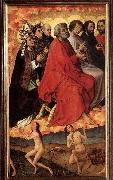 |
The Last Judgment |
1446-52 Oil on wood Mus?e de l'H?tel Dieu, Beaune Above is a cloud of gold, on which are seated the apostles, judges in the celestial tribunal, as well as a pope, a bishop, a king, a monk and three women. Below them is the earth, from which the resurrected souls emerge, to go either to damnation or to eternal bliss.Artist:WEYDEN, Rogier van der Title: The Last Judgment (detail) Painted in 1401-1450 , Flemish - - painting : religious |
| 63890 |
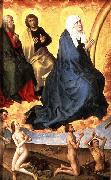 |
The Last Judgment |
1446-52 Oil on wood Mus?e de l'H?tel Dieu, Beaune The central panel is dominated by the son of God, seated on a semi-circular rainbow, with the Virgin Mary at one end of the arc and St John the Baptist at the other.Artist:WEYDEN, Rogier van der Title: The Last Judgment (detail) Painted in 1401-1450 , Flemish - - painting : religious |
| 63891 |
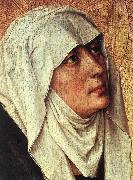 |
The Last Judgment |
1446-52 Oil on wood Mus?e de l'H?tel Dieu, Beaune The detail shows the head of Mary.Artist:WEYDEN, Rogier van der Title: The Last Judgment (detail) Painted in 1401-1450 , Flemish - - painting : religious |
| 63892 |
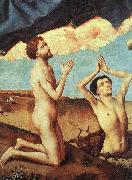 |
The Last Judgment |
1446-52 Oil on wood Mus?e de l'H?tel Dieu, Beaune The detail represents the elect.Artist:WEYDEN, Rogier van der Title: The Last Judgment (detail) Painted in 1401-1450 , Flemish - - painting : religious |
| 63893 |
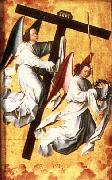 |
The Last Judgment |
1446-52 Oil on wood Mus?e de l'H?tel Dieu, Beaune The picture shows the upper panel to the left.Artist:WEYDEN, Rogier van der Title: The Last Judgment (detail) Painted in 1401-1450 , Flemish - - painting : religious |
| 63894 |
 |
The Last Judgment |
1446-52 Oil on wood Mus?e de l'H?tel Dieu, Beaune The central panel is dominated by the son of God, seated on a semi-circular rainbow, with the Virgin Mary at one end of the arc and St John the Baptist at the other. Christ's feet rest on a sphere, symbol of the universe. With his right hand, he blesses those who are saved and with his left curses those who are damned. These two gestures are emphasized by appropriate emblems, respectively, a lily and a blazing sword. Beneath Christ stands St Michael, prince of the heavenly hosts. He is pictured as young, because he is immortal and as handsome, because he is the embodiment of divine justice. He holds in his hands a scale in which he weighs souls. The souls are represented by two little naked figures, whose names are "Virtutes" and "Peccata". The former kneels, overcome with delight, while the latter seems horrified and screams with terror.Artist:WEYDEN, Rogier van der Title: The Last Judgment (detail) Painted in 1401-1450 , Flemish - - painting : religious |
| 63895 |
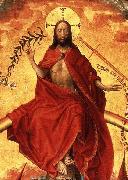 |
The Last Judgment |
1446-52 Oil on wood Mus?e de l'H?tel Dieu, Beaune The central panel is dominated by the son of God, seated on a semi-circular rainbow.Artist:WEYDEN, Rogier van der Title: The Last Judgment (detail) Painted in 1401-1450 , Flemish - - painting : religious |
| 63896 |
 |
The Last Judgment |
1446-52 Oil on wood Mus?e de l'H?tel Dieu, Beaune St Michael holds in his hands a scale in which he weighs souls. The souls are represented by two little naked figures, whose names are "Virtutes" (this picture) and "Peccata". The former kneels, overcome with delight, while the latter seems horrified and screams with terror.Artist:WEYDEN, Rogier van der Title: The Last Judgment (detail) Painted in 1401-1450 , Flemish - - painting : religious |
| 63897 |
 |
The Last Judgment |
1446-52 Oil on wood Mus?e de l'H?tel Dieu, Beaune The picture shows a detail of the central panel. Four angels sound trumpets at the feet of Christ; they announce the Last Judgment and waken the dead. They surround the Archangel Michael, who, resplendent in his white robe scarlet cloak, impassively weighs the resurrected. The scale on his left sinks under the weight of the sins of one of the damned screaming in terror while in the other, one of the chosen seems to be expressing his thanks to the Archangel. One cannot fail to admire the delicate brushwork and colouring of the brooch holding the Archangel's cloak.Artist:WEYDEN, Rogier van der Title: The Last Judgment (detail) Painted in 1401-1450 , Flemish - - painting : religious |
| 63898 |
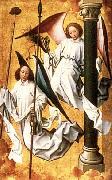 |
The Last Judgment |
1446-52 Oil on wood Mus?e de l'H?tel Dieu, Beaune The picture shows the upper panel to the right.Artist:WEYDEN, Rogier van der Title: The Last Judgment (detail) Painted in 1401-1450 , Flemish - - painting : religious |
| 63899 |
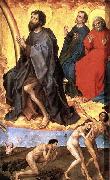 |
The Last Judgment |
1446-52 Oil on wood Mus?e de l'H?tel Dieu, Beaune The central panel is dominated by the son of God, seated on a semi-circular rainbow, with the Virgin Mary at one end of the arc and St John the Baptist at the other.Artist:WEYDEN, Rogier van der Title: The Last Judgment (detail) Painted in 1401-1450 , Flemish - - painting : religious |
| 63900 |
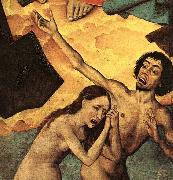 |
The Last Judgment |
1446-52 Oil on wood Mus?e de l'H?tel Dieu, Beaune The picture shows a detail of the third panel from the right: group of the damned.Artist:WEYDEN, Rogier van der Title: The Last Judgment (detail) Painted in 1401-1450 , Flemish - - painting : religious |
| 63901 |
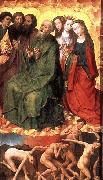 |
The Last Judgment |
1446-52 Oil on wood Mus?e de l'H?tel Dieu, Beaune Above is a cloud of gold, on which are seated the apostles, judges in the celestial tribunal, as well as a pope, a bishop, a king, a monk and three women. Below them is the earth, from which the resurrected souls emerge, to go either to damnation or to eternal bliss. In line with traditional thinking, the dead have all risen at the age of 33, Christ's age when he died. The damned souls among them, crying out in despair, move of their own accord toward the fiery mouth of Hell. The limbs of the angular nude figures, still very Gothic in concept, create a complex interlocking pattern.Artist:WEYDEN, Rogier van der Title: The Last Judgment (detail) Painted in 1401-1450 , Flemish - - painting : religious |
| 63902 |
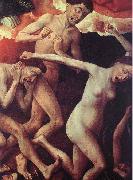 |
The Last Judgment |
1446-52 Oil on wood Mus?e de l'H?tel Dieu, Beaune The detail shows a group of the damned. In Van der Weyden's time it was believed that lunatics were possessed by demons. Here, the figures of the damned are tortured and deformed by hatred and their faces distorted by madness. Gripped by a collective hysteria, they are unable to weep, but instead scream and fight, as their folly draws them on towards eternal punishment.Artist:WEYDEN, Rogier van der Title: The Last Judgment (detail) Painted in 1401-1450 , Flemish - - painting : religious |
| 63903 |
 |
The Last Judgment |
1446-52 Oil on wood Mus?e de l'H?tel Dieu, Beaune At the far left-hand side of the polyptych, paradise is represented as a gothic porch ablaze with light, the door that leads to the divine dwelling place. On the other side, hell is strangely lacking in devils. Instead, it is merely represented by a pile of dark rocks spewing flames and volcanic vapours.Artist:WEYDEN, Rogier van der Title: The Last Judgment (detail) Painted in 1401-1450 , Flemish - - painting : religious |
| 51142 |
 |
The Last Judgment Polyptych |
1446-52
Oil on wood,
215 x 560 cm |
| 63886 |
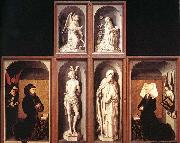 |
The Last Judgment Polyptych |
1446-52 Oil on wood Mus?e de l'H?tel Dieu, Beaune As long as the polyptych hung in its original place, it was traditional to open the wings on Sundays and solemn feast days. But since it has been restored, it is now kept in a neighbouring room which is air-conditioned to prevent any further deterioration due to the heat generated by the three hundred thousand visitors who come to see it each year. The panels were sawn in half across the thickness of the wood a few years ago, and both front and the reverse are now exhibited simultaneously, side by side. The reverse of the panels of the polyptych depict the donors. Nicolas Rolin is an old man, whose nose is too long and whose hair has been cut short. Guigonne de Salins lowers her eyes and gestures with her joined hands towards her book of hours; on her head she wears a starched net veil. Behind each of them, an angel is carrying a shield emblazoned with their respective coats-of-arms. Rolin is facing towards an elegant imitation statue of St Sebastian executed in grey tint, as if carved from marble. His wife is looking towards another imitation statue, this time of St Anthony, who is accompanied by a young pig.Artist:WEYDEN, Rogier van der Title: The Last Judgment Polyptych (reverse side) Painted in 1401-1450 , Flemish - - painting : religious |
| 63887 |
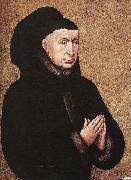 |
The Last Judgment Polyptych |
1446-52 Oil on wood Mus?e de l'H?tel Dieu, Beaune The detail shows Chancellor Nicolas Rolin, founder of the H?tel-Dieu in Beaune from one of the outer panels of the Last Judgment Polyptych. The donor of the Hospices de Beaune must have been an extremely powerful and wealthy man to finance such an undertaking. Nicolas Rolin spent nearly sixty of his eighty-one years in the service of the Dukes of Burgundy. For twenty years he was their legal advisor; he spent the remaining years as chancellor. A chancellor in the Middle Ages was a "superminister" combining the functions of Minister of Finance, Home and Foreign Affairs and others. It is not surprising that a capable and intelligent man holding so much power and with more than half a century in the favour of one master, should amass considerable wealth. And that master was no ordinary man. Philippe-le-Bon (Philip the Good), Duc de Bourgogne, Grand Duc d'Occident, could say without exaggeration that "I could be king if I so wished". He was a vassal of the King of France, but infinitely richer and more powerful than the unfortunate Charles VII. Through a series of judicious marriages and annexation of lands after victories, the Dukes of Burgundy, from the days of Jean-Sans-Peur (Fearless John), built up vast spheres of influence, a patchwork of regions and races extending around the Kingdom of France in a crescent from just north of Lyons to just south of Amiens and from there to northern modern Holland. Philippe-le-Bon entrusted the management of this vast domain to Nicolas Rolin. Certain chroniclers contend that his management was not entirely disinterested and that the magnificence of the Hospices directly reflects the degree of his remorse for his actions. Nevertheless, it has been recorded that, assailed by criticism and reproaches and accused of misappropriation of funds, Nicolas Rolin, in order to silence envious tongues, appeared before Philippe-le-Bon dressed in the humble robes of a lawyer with a list in his hand and offered to return all the gifts which the Duke had showered upon him. The Duke refused this offer and was pleased that there was still room on this list for further gifts! There was nothing to indicate that the Rolins, a modest family from Autun, were destined for such greatness. Nicolas needed unrelenting determination and persistence to successfully ascend the social ladder. As Councillor to Jean-Sans-Peur and, after 1422, Chancellor to Phillipe-le-Bon, Nicolas Rolin showed himself to be not only an able administrator but also a canny politician who succeeded in extricating the Duchy of Burgundy from an alliance with the English which became onerous after the glorious progression of Joan of Arc and the change in fortune of Charles VII. He was also one of the authors of the Treaty of Arras, the instrument which reconciled France and Burgundy and ended the Hundred Years' War. Nicolas Rolin's pride and authoritarian nature are clearly reflected in the first words of the charter creating the Hospices, "I wish and hereby order... I wish and hereby devise that... ". In 1443, desirous of helping Beaune, the city of his mother's birth, recover from the devastation of the Hundred Years' War, Nicolas Rolin decided to build a hospital, "ignoring all worldly concerns and in the interests of my salvation ". After the main outlines of his project were established, Rolin, enamoured of the richness of Flemish architecture, imported an artist - thought to have been Jean Wiscrere - from the "flat country" to construct the Hospices in the image of the H?pital Saint-Jacques in Valenciennes. The Chancellor had initially calculated that the work begun in 1443 would take five years. In fact, the building was not dedicated until December 31, 1451. Nicolas and his wife, Guigone de Salins, welcomed six nuns from Flanders the next day and the first patient was admitted several hours later. The last patient left the Hospices in 1971, 520 years later.Artist:WEYDEN, Rogier van der Title: The Last Judgment Polyptych (detail) Painted in 1401-1450 , Flemish - - painting : religious |
| 51161 |
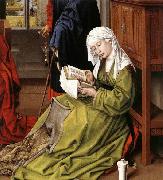 |
The Magdalene Reading |
c. 1445
Oil, transferred from wood to mahagony,
62 x 55 cm |
| 51174 |
 |
Triptych of the Redemption |
1455-59
Oil on panel,
195 x 326 cm |
| 51165 |
 |
Virgin and Child |
c. 1440
Oil on panel,
100 x 52 cm |
| 51182 |
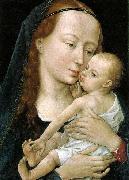 |
Virgin and Child after 1454 |
Oil on panel,
31.9 x 22.9 cm |
| 51180 |
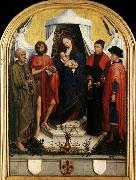 |
Virgin with the Child and Four Saints |
1450-51
Oil on panel,
61,7 x 46,1 cm |
| 63876 |
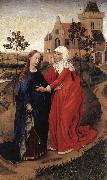 |
Visitation |
1445 Oil on oak panel, 57 x 36 cm Museum der Bildenden K?nste, Leipzig This small Visitation, probably intended as a single panel, is related to the Miraflores Altarpiece, not in subject but in style. Comparatively speaking, it is a narrative picture, showing a definite event in its appropriate surroundings. Shortly after the Annunciation, Mary visits her cousin Elisabeth, who despite her advanced age has miraculously become pregnant, and has been carrying the future John the Baptist for six months. The picture illustrates the circumstances of the meeting described in St. Luke's Gospel much more clearly than many other earlier depictions. For example, the landscape divided up by paths behind the Virgin Mary, from which she seems to be approaching small figures of people riding and walking indicate that it is passable - show that she has traveled a long way to visit her cousin. Elisabeth lives in hilly country, represented by the hill with the complex of fortress-like buildings outside which her husband Zacharias is playing with a dog. The open courtyard gateway, and even more so the path dynamically winding downward, show that the pregnant older woman has hurried respectfully to meet the young girl as Mary takes the last few steps. Each of them acknowledges the miracle of pregnancy and is laying a hand on the other's belly, while Elisabeth's outstretched arm and pale hand, shown against Mary's dark blue dress, leave us in no doubt which is the more important child. The gestures, at once tender and eloquent, are typical of Rogier's expressive style. The picture is also closely related to the version of the same subject on the right wing of the Annunciation Triptych (Galleria Sabauda, Turin) which is of the same width but considerably taller and thus makes a much narrower composition. The smaller version therefore appears less dramatic by comparison; Elisabeth's house does not tower over her so much. It is possible that an older design by Rogier was the model for both painting. These hands and facial types, the figures, and such features as the modeling of the forms resemble those of the Miraflores Altarpiece. Dendrochronology provides a useful lead to the date of the Visitation, for the wooden panel used comes from the same piece of timber as a part of the panels of the picture known as the Abegg Triptych (Riggisberg near Berne), which was painted in Rogier's workshop and can be dated to around 1445.Artist:WEYDEN, Rogier van der Title: Visitation Painted in 1401-1450 , Flemish - - painting : religious |
| 63883 |
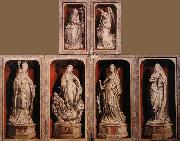 |
Wing of a Carved Altar |
1460-66 Oil on panel Church, Ambierle When Rogier died in Brussels on 18 June 1464, he was the best known and most sought after painter in the Netherlands, an exemplar to the majority of artists north of the Alps. He left behind him not only an obviously large workshop with extremely well trained assistants, but also a continuing demand for his work. The studio was very probably taken over by his son Pieter; it will have completed commissions on which he had embarked, also accepting new orders. One of these works, possibly commissioned in Rogier's own lifetime, consisted of the wing paintings for an altar in Ambierle in France, completed in 1466. It has been proved that the carved central shrine of this altar came from Brussels. The distinguished patrons in Brussels who commissioned it obviously turned to the town painter's famous workshop, where large and impressive paintings similar in typology to Rogier's own were produced, although certainly no longer by the master himself. The altar was donated by Michel de Chaugy, a counsellor of Philip the Good. The shrine in the retable shows carved scenes of the Passion; the donor's family, with its patron saints, occupies the wings. Stone figures of saints are depicted in niches on the exterior. In its construction, this work reflects the exterior of the Beaune Altarpiece.Artist:WEYDEN, Rogier van der Title: Wing of a Carved Altar Painted in 1401-1450 , Flemish - - painting : religious |
|
|
|
Prev 1 2
|
|
| WEYDEN, Rogier van der
|
| Netherlandish Northern Renaissance Painter, ca.1400-1464
major early Flemish master, known also as Roger de la Pasture. He is believed to have studied with Robert Campin. His early works also show the influence of Jan van Eyck. Van Eyck, however, had been a master at objective rendering of detail, whereas Roger in his work portrayed emotions with an assurance that has not been surpassed. His ability to depict piety is reflected in the early masterpiece Descent from the Cross (c.1435; Prado); he depicted with significant restraint the profound grief of the mourners grouped around the tragic figure of Jesus. His composition strongly affected later representations of the theme. Roger became City Painter in Brussels in 1436. He then produced a series of undated altarpieces including the Last Judgment (hospital, Beaune), the Braque Triptych (Louvre), Crucifixion with Donors (Vienna), and Adoration of the Magi (Berlin), which vary in execution from a stress on sumptuous details to a more sculptural rendering of the figures. Roger is believed to have made a pilgrimage to Italy in the holy year 1450. Whether this supposed excursion had any effect on his style is much debated. It has been shown that his Entombment (Uffizi) bears an affinity to the Tuscan treatment of the subject, particularly by Fra Angelico, and that Roger's Virgin and Child with Saints (Frankfurt) has a strong resemblance to the Italian religious art of the day. His style is, however, highly individual. His religious paintings and his portraits are characterized by a straightforward monumentality. The portraits, such as that of a young lady (National Gall. of Art, Washington, D.C.) and of Francesco d'Este (Metropolitan Mus.) exhibit a simple clarity of contour and psychological penetration. Other notable works are his St. Luke Painting the Virgin, of which a version or replica is in the Museum of Fine Arts, Boston, the Crucifixion
|
|

